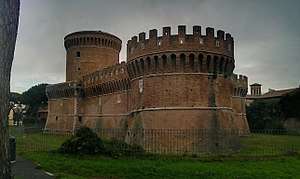Ostia Antica (district)
Ostia Antica is the 35th zona of Rome, Italy, four kilometers away from the coast. It is identified by the initials Z. XXXV and it is distinct from Ostia. Part of Municipio X.
Ostia Antica | |
|---|---|
Zona of Rome | |
 The Castle of Julius II in Ostia Antica. | |
 Position of the zona within the city | |
| Country | |
| Region | Latium |
| Province | Rome |
| Comune | Rome |
| Area | |
| • Total | 5.7903 sq mi (14.9967 km2) |
| Population (2016)[1] | |
| • Total | 11,681 |
| • Density | 2,017.3/sq mi (778.90/km2) |
| Time zone | UTC+1 (CET) |
| • Summer (DST) | UTC+2 (CEST) |
History
Under the Romans, Ostia Antica reached a peak of some 75,000 inhabitants in the 2nd and 3rd century AD. A slow decline began in the time of Constantine I, and the city became an episcopal see as part of the Diocesi of Rome as early as the 3rd century AD. St. Augustine passed through in the late 4th century. His mother, St. Monica, died here in 387 in a house property of the Diocesi of Rome. The poet Rutilius Namatianus also reported the lack of maintenance of the city in 414. Recent excavations, however, put the date of decline later. The city contained 26 operating baths in the 4th century and there is plenty of evidence of repairs on public buildings and the construction of new edifices. Though showing decay in some areas, the late period is one of transition from a city filled with workers employed in collecting, storing and moving huge amounts of grain, oil and wine (and other products) to feed Rome to one with the character of a seaside resort. The city remained prosperous into the 5th century. It was the seat of the Prefect of the Annona. There is expansion beyond the western and southern walls in the area of the Porta Marina.[2] Ostia became an episcopal see as early as the 3rd century AD, with the cathedral (titulus) of Santa Aurea erected over the tomb of St. Monica.
As the centuries passed, Ostia fell into ruin but continued to provide maritime access for visitors to Rome. Saracen pirates were a frequent concern; the naval Battle of Ostia was fought off the coast in 849. Pope Gregory IV fortified the existing burgh and it was rechristened Gregoriopolis. By this time, the shifting course of the Tiber had landlocked the ancient port, and the town was mainly a shelter for the workers of the nearby salt mills.
In the late 15th century, the bishop Giuliano della Rovere (later Pope Julius II) commissioned the rebuilding of the main church and town walls under the direction of the architect Baccio Pontelli. The Castle of Julius II, also built at this time, remains the most striking feature of modern Ostia. The castle was abandoned after a flood in 1587 inundated its moat and turned the surrounding area into a marsh.
The castle and the town were restored again in the 20th century.
In popular culture
- Ostia was featured in the novels I, Claudius and Claudius the God, both written by British novelist Robert Graves. The novels include scenes set at Ostia spanning from the reign of Augustus to the reign of Claudius, including the departure of Agrippa to Syria and Claudius's reconstruction of the harbour. In the 1976 television series, Ostia was frequently mentioned but never actually seen.
- Ostia appears briefly towards the end of the Roman Empire section of the 1981 comedy film History of the World, Part I, where the main characters board a galleon (bearing the El Al logo) bound for Judaea. In the film, however, Ostia is only ever referred to as simply "the port".
- Ostia is the home town of the main characters of the children series, The Roman Mysteries by Caroline Lawrence.
References
- Roma Capitale – Roma Statistica. Population inscribed in the resident register at 31 December 2016 by toponymy subdivision.
- Douglas Boin, Ostia in Late Antiquity, 2013, pp. 21, 24, 56–57, 65, 232–236 ISBN 978-1-316-60153-2
- Lorenzatti Sandro, Ostia. Storia Ambiente Itinerari Roma 2007 (Rome:Genius Loci)
- Site of the Centro Studi Storici Ambientali Ostia and of Genius Loci Publisher (Italian)